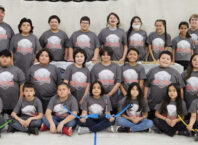By Lee Egerstrom
Minnesota recorded 35 new deaths from the COVID-19 pandemic on Oct 20, the highest daily death count since May 28 and a day after Minnesota state officials told state employees to “work from home if you can” until June next year.
This guidance for state employees came as families must make plans for childcare and for others to combine work – called “telework” – with overseeing children who are also at home with “distance learning” school schedules. It isn’t easy wearing different hats during the day but state officials said they must alert an estimated 28,000 state workers now working from home that this is the reality they face in the months ahead.
It also comes after the federal Center for Disease Control and Prevention (CDC), Johns Hopkins University researchers and other tracker found the pandemic on an upswing in 41 states just as the regular flu season is starting to hit.
This has consequences for Minnesota’s Native community and for other ethnic communities that often have multi-generational home living arrangements. While staying close to home limits exposure to the virus, it also exposes especially vulnerable elderly to family members who may become infected. And, it also means greater numbers of people must pitch in with child care and helping with remote learning school experiences.
That isn’t easy, said Mary Watson, financial management officer for Ventura Village in Minneapolis where the Native community around Franklin Avenue shares a diverse neighborhood with Somalis, numerous Hispanic / Latino groups, and others.
Watson divides work for Ventura Village with being a grandmother – school aide for a granddaughter who is taking classes away from the classroom. “It’s like being a teacher,” she said when she returned a call to The Circle well past business hours. “There’s a lot of things to juggle.”
Staying health, however, just might be the biggest challenge.
Minnesota is surrounded by a hotbed of states being hit with a surge of the virus. Our numbers are rising as well.
The CDC on Oct. 21 found North Dakota led the nation over the previous seven days with 98.1 cases for 100,000 population. With this per capital measurement, South Dakota was second with 82.9 cases, Wisconsin third with 59.1 cases and Montana was fourth with 55.5 cases.
Iowa was 11th highest among U.S. states and territories with 35.5 cases per 100,000 population while Minnesota ranked 17th with 27.1 cases.
The vulnerability of the elderly was evident in Minnesota’s daily COVID-19 briefing on Oct. 21. Of the 35 deaths reported the day before, 25 fatalities were among residents of long-term care facilities and all were age 60 or higher. Thirteen were people 89 or older.
Federal and state health officials have warned the pandemic will likely worsen as people do more things indoors to avoid the cold and as other seasonal infections may be weakening people’s defense mechanisms.
Anticipating that COVID-19 may get worse, not better, some Minnesota-based companies and local governments had already started warning employees to plan for extended work from home experiences until June. That would coincide with the return of warmer weather, and for parents and other childcare providers, with the length of the current school year.
Target Corp. was among them. WCCO-TV reported on Oct. 8 that Melissa Kremer, Target’s chief human resources officer, said in an email to the company’s 8,500 headquarters employees who normally work downtown Minneapolis that it is hard to image we’ve been coping with the pandemic for more than half a year.
“I never imagined that we’d transition to remote work in the spring and that I’d be writing this message to you, still from home, in the fall,” her email said.
What businesses and government bodies do will be influenced by what federal and state health officials discover in tracking COVID-19, and what they recommend as best practices for staying safe.
Here are online sites for monitoring what health experts are saying, and what is unfolding around us.
Basic information can be accessed at https://mn.gov/covid19/, and for special worker support information at https://mn.gov/covid19/for-minnesotans/get-help/employment.jsp.
Multi-generational families and others concerned about possibly vulnerable loved ones should be aware that “unknown community” is the largest category of residency where health workers have tracked infected cases. In other words, the source of the infection is from the community but actual source in unknown. That data is available at https://mn.gov/covid19/data/covid-dashboard/cases-by-type.jsp.







